There are a number of possibilities on how to accomplish the optimal environment for a cell culture. Whether it be a closed system, for instance, an incubation shaker or the combination of shakers and climate chambers, the choices are many.
Most cell culture laboratories will typically have a climate chamber as a staple inventory. As incubation shakers take a lot of space, which is hard to find in most laboratories, the implementation of shakers and existing climate chambers tends to be useful.
This whitepaper details the importance of temperature stability during cultivation. For that, the impact of Heidolph shakers on the temperature of Memmert climate chambers was put to the test.
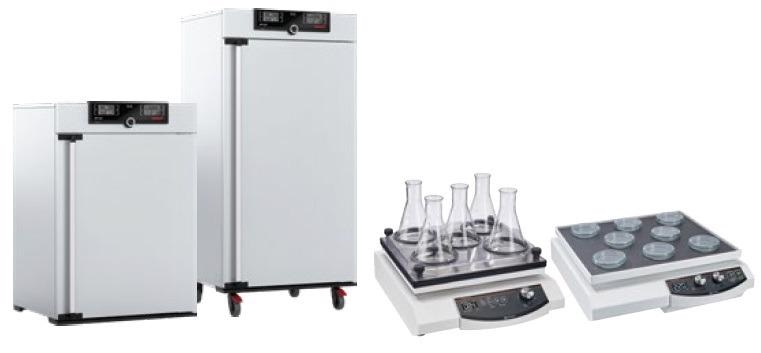
Image Credit: Heidolph North America
The Many Challenges of Cell Culture
Using microorganisms to produce various commodities is garnering increased attention across the overall life science fields. Whether for the mass production of medicine, like Insulin, or the production of fine chemicals, the benefits are clear to see.
These include using by-products from the process as renewable raw materials to reduce conventional multi-stage chemical processes through one fermentation stage. Sometimes, biotechnological procedures are the only way to manufacture certain products.
With greater popularity in industrial as well as research fields, there are various ways to use microorganisms for manufacturing processes.
As there are pros in the preparation and production, there are also cons. For instance, it’s vital to always ensure a sterile environment, the overall biomass yield can vary from batch to batch, as well as the composition of the complex media used.
These are just a few illustrations on what’s crucial during the working process with microorganisms or in the overall cell culture field. To not lose sight of what is salient for the process, it’s critical to thoroughly plan the procedure from start to finish.
Choosing the Right Parameters for the Process
One of the main factors for the entire process is the microbial growth. Depending on what kind of microorganism is selected for the process, various parameters have to be considered. Those can be divided into chemical and physical categories.
Chemical parameters are the formation of nutrient media (macro- and microelements) and oxygen concentration. Physical parameters mostly regard everything around the used reactor, incubator, or climate chamber.
These include the pH, temperature, osmolarity and sheer stress caused by the stirring unit. The temperature is a key factor for the entire process as it controls chemical and enzymatic reactions within the cell.
Climate Chamber – An Allrounder in Every Laboratory
A climate chamber is used for the cultivation of sheer stress-sensitive cells, agar plates and for analytical methods, such as hybridization. There is also a wide variety of climate cabinets available.
Most models are fitted with a temperature range of +5°C over room temperature up to 100°C, as well as the potential to enrich the atmosphere with CO2, which is a crucial factor in cell cultivation.
If the application demands temperatures below 25°C, a climate chamber with cooling connections and an internal cooling system is the optimal choice.
The aforementioned technical features are also found in incubation shakers. So benefit comes when combining a shaker with a climate cabinet? As almost every laboratory experiences problems regarding space, it is obvious to use all resources available.
While the necessity to simultaneously shake and incubate the cells on a daily basis may be superfluous to requirements, it is straightforward to place an already available shaker in the climate cabinet.
The use of shakers with various motions in one chamber is possible. Therefore the potential to perform various applications at once increases.
Objective: Testing the Influence of Continuous Shaking on the Media Temperature Within Climate Chambers
The impact of temperature fluctuations on microbial growth is a key variable. Heidolph tested the influence of the Unimax 1010 on temperature while performing continuous shaking in the Memmert HPP260 and HPP410 climate chambers.
Method: Influence of Heidolph Unimax 1010 Shaker on Temperature Fluctuations in Memmert Climate Chambers
The test series are performed with two climatic chambers of different sizes. Depending on the size of the climatic chamber and the available space, a different number of shakers can be installed.
The Memmert HPP260 is fitted with two shakers, while the Memmert HPP410 has three shakers of the same series. The actual temperature measurement is performed inside the medium.
For that, an Erlenmeyer flask with a one-liter volume is filled with 800 ml of water; the rpm set to 80; the total time of the experiment is 48h.
A: Memmert HPP260 in Combination with Two Heidolph Unimax 1010
One Heidolph Unimax 1010 is fitted with the attachment for Erlenmeyer flasks. A second shaker – also an Unimax – is positioned in the climatic cabinet. The experimental assembly can is illustrated in figure 1.
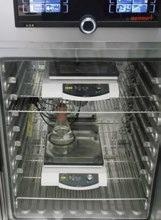
Figure 1. Experimental setup of two Heidolph Unimax 1010 in the Memmert HPP260. Image Credit: Heidolph North America
To monitor the temperature throughout the experiment, the sensor is placed inside the medium. Table 1 exhibits the general conditions of the experiment. The experiment’s temperature-time curve can be seen in figure 2.
Table 1. Parameters used in the experiment. Source: Heidolph North America
| Set parameters |
| Shaking frequency |
Temperature |
Time |
Volume (water) |
Humidity control |
| 80 rpm |
37 °C |
2,872 min |
800 ml |
off |
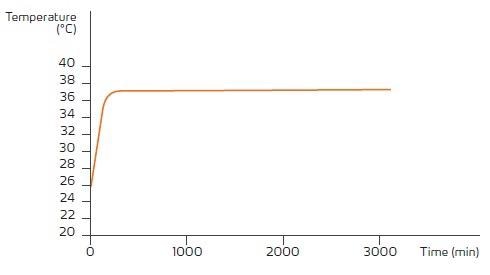
Figure 2. Experimental setup of two Heidolph Unimax 1010 in the Memmert HPP260. Image Credit: Heidolph North America
At the start of the experiment, the medium has a temperature of 25.6°C and the desired actual temperature of 37 degrees is achieved after 374.1 minutes. In order to acquire an exact image of temperature fluctuations, the experiment is run for around 48 hours. All results from the experiment are outlined in Table 2.
Table 2. Results of the test carried out with two Heidolph Unimax 1010 over 48 hours at 37 °C. Source: Heidolph North America
| Results |
| Time to reach set Temperature |
Deviation to set temperature 37 °C |
| 374 min |
±0.3 °C |
B: Memmert HPP410 in Combination with Three Heidolph Unimax 1010
The test series is predicated on the experiments with the Memmert HPP260. The variable detail is that three shakers were placed in the climate cabinet Memmert HPP410. Three Heidolph Unimax 1010 units are positioned in the Memmert HPP410. One of the shakers is fitted with the Erlenmeyer flask attachment.
The media volume is 800 ml respectively; the thermometer is set in to the media. The desired temperature for holding is 37 degrees, and the experiment lasts for 2,872 minutes. A speed of 80 rpm is set on the shakers. Table 3 demonstrates a summary of all set parameters for the test series.
Table 3. Parameters for the test series. Source: Heidolph North America
| Set parameters |
| Shaking frequency |
Temperature |
Time |
Volume (water) |
Humidity control |
| 80 rpm |
37 °C |
2,872 min |
800 ml |
off |
The course of the test series is shown in figure 3. At the start of the experiment, the temperature of the medium is 22.8°C and the desired temperature – 37°C – is achieved after 372 minutes.
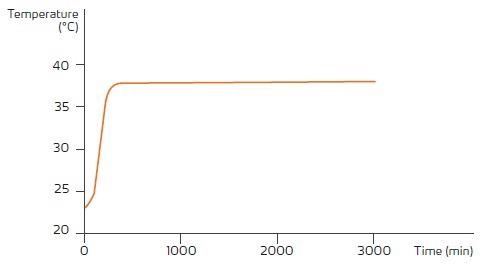
Figure 3. Graph of temperature stability of the media during 2872 min in the climate chamber Memmert HPP410 with three Heidolph Unimax 1010. Image Credit: Heidolph North America
The experiment is run for 48h so that any variations in temperature can be directly observed. As an overall result, the deviation from the set temperature is ±0,7°C, respectively. An outline of the results can be seen in table 4.
Table 4. Results of the test carried out with the Memmert HPP410 and three Heidolh Unimax 1010 units. Source: Heidolph North America
| Results |
| Time to reach set Temperature |
Deviation to set temperature 37 °C |
| 372 min |
±0.7 °C |
C: Discussion of the Result
The temperature deviation during the test series of the Memmert HPP260 is ±0.3°C, respectively. This deviation can be easily adapted during the application or incubation of the cell culture.
All in all, the influence of two Heidolph Unimax 1010 units on the durability of the climate cabinet is low. The fluctuations in the temperature with three shakers in the Memmert HPP410 is ±0.7°C. This is within the range of variance, which means that this experimental setup is appropriate for sensitive applications.
Conclusion: Operating Heidolph Shakers in Memmert Climate Chambers is a Solution for Cell Cultivation
The test series demonstrate that there are no considerable temperature deviations when continuously operating Heidolph Unimax 1010 shakers in Memmert climate chambers. Additionally, the growth of temperature-sensitive organisms is not inhibited. Overall it is a well-built and progressive tool to drive the process forward.
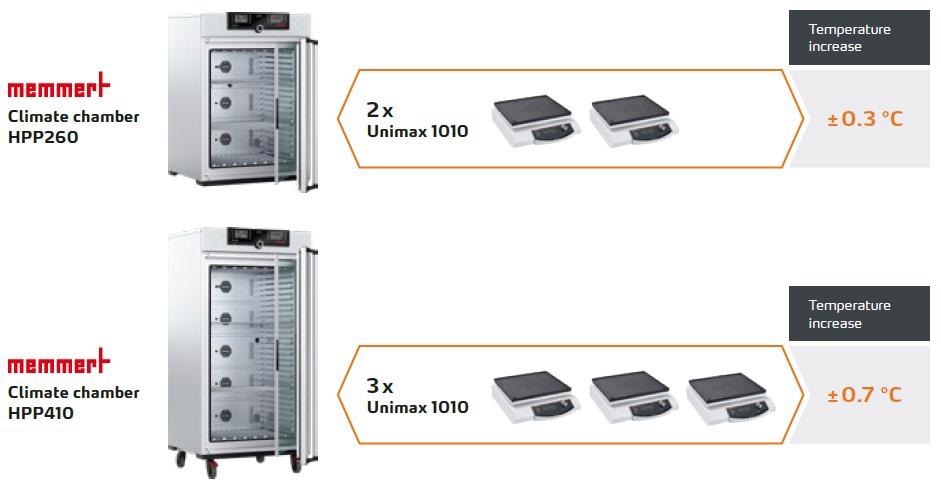
Image Credit: Heidolph North America

This information has been sourced, reviewed and adapted from materials provided by Heidolph North America.
For more information on this source, please visit Heidolph North America.